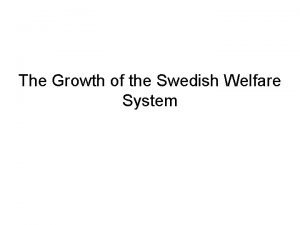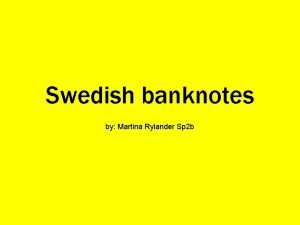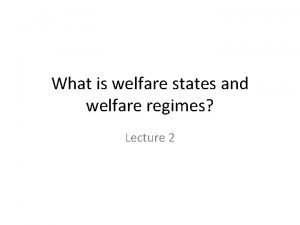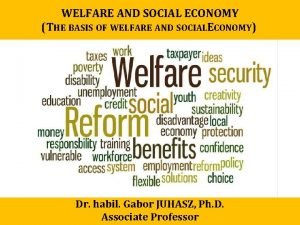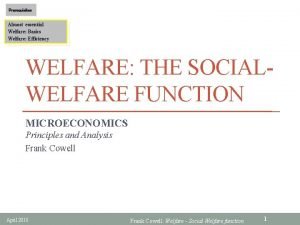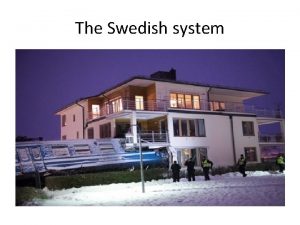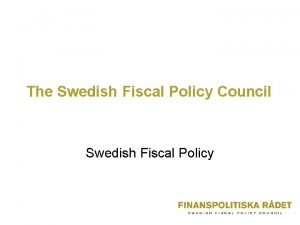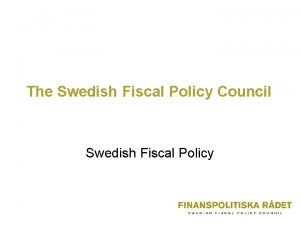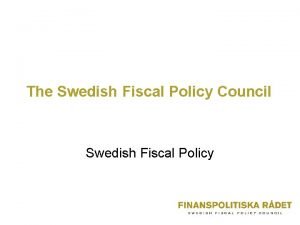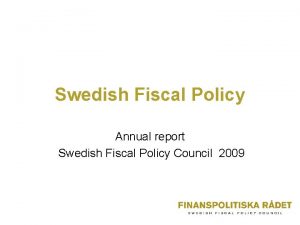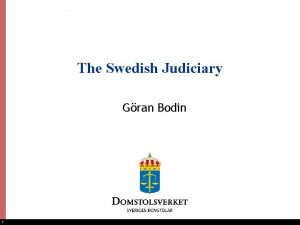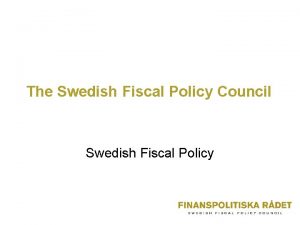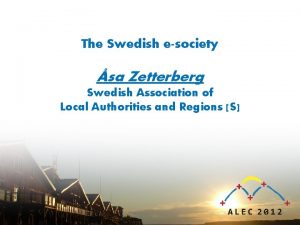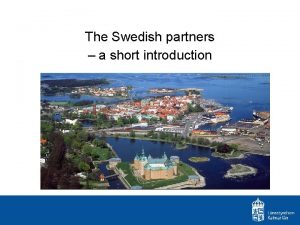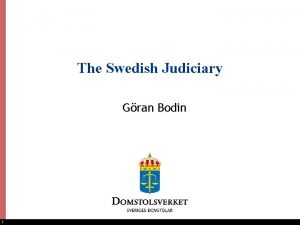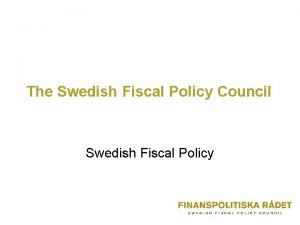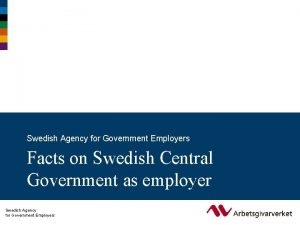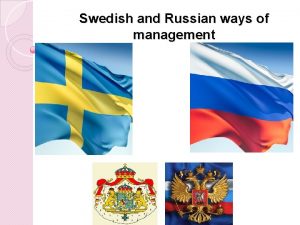The Growth of the Swedish Welfare System The
















































- Slides: 48

The Growth of the Swedish Welfare System

The “People’s Home” is born

”Folkhemmet”, or ”The People’s Home” • The core normative concept underlying the welfare state • The meaning: everyone is taken care of; not just the rich, nor only the poor, but everyone regardless of income. • “Generell välfärd” or “general welfare”, meaning that provisions are given equally to all – not income-related. • Also, a wide array of services: free education, free healthcare, sports centers, libraries, “book buses”, “fluorine ladies”… • The history of this concept is very interesting and revealing!

The history of ”folkhemmet” • In the wider meaning, used by Rudolf Kjellén (1864 -1922), famous Swedish political scientist and conservative politician and MP. • Kjellén was professor at…this department of political science (you can see his portrait on the fifth floor, next to Bo Rothstein’s room!) • Kjellén influenced Ernst Wigforss as well as Gunnar Myrdal; top social democratic intellectuals. • Kjellén also influenced others…he coined the concept of “geopolitics” and used the notions of “Reich” and “Lebensraum”… • (He also spoke of the “Ideas of 1914” as opposed to the “Ideas of 1789” and supported Germany in WW I, like many other famous Swedish intellectuals at the time).

“Folkhemmet” – why? • In the latter half of the 19 th century, Sweden was rapidly industrializing. • The last famine was in the 1860’s, but from 1870 -1970, growth in Sweden exceeded that of other countries. • As workers flocked to the cities, a worker’s movement began forming. • SAP, the Social Democratic Worker’s Party, was formed in 1889. • Two main goals: 8 hour week, and universal suffrage.

(continued) • In the early 20 th century, Sweden was still largely conservative and the king relatively powerful. The intellectual elites, people like Kjellén, were Germanfriendly. • But world war I was a setback for the conservative establishment. The prime minister, Hammarsköld, was nicknamed “Hungersköld”, because there was little food due to the war. • Fearing a revolution, the king and the conservatives gave in to the demands advanced by liberals and social democrats: in 1919, the 8 -hour week was introduced, and in 1921, universal suffrage. • The 1920’s saw the return of rapid growth and Swedish companies were very successful. Politically, the country was dominated by various centreright coalition governments. • The social democrats were becoming a powerful force, but they had yet to attain power and stay there.

“Folkhemmet” becomes a social democratic vision • In 1928, social democrat leader Per Albin Hansson is looking for an ideal to rally people behind the social democrats. He wants to avoid being branded as a left-wing extremist. • In the 1928 elections, the so-called “Cossack elections”, the social democrats are described as “Bolsheviks” by their opponents and the conservatives win. • So the social democrats are looking for something to unite people in a national as well as socialist vision, to become a mainstream party and gain power. • It is now that, in a brilliant rhetorical move, Per Albin Hansson borrows the conservative notion of a “people’s home” and makes it his own key ideal. • He tries to decide between a “citizen’s home” and a “people’s home” and chooses the latter. • Soon afterwards, the Great Depression strikes the Western World and the social democrats win the elections in 1932. They have finally gained power and will keep it until 1976!

Two election posters: 1928, conservative poster accusing the social democrats of being ”Bolsheviks”; 1936, social democrat poster showing the vision of a Swedish people’s home (note the strong, blonde, male workers and the row of identical houses!)

To conclude: • The social democrats were able to take the vision of their opponents and make it their own, by a daring synthesis of Swedish nationalism and socialist modernism. • The ideas of the pre-World War I conservative intellectuals were not simply rejected, but rather transformed into a new framework! • The social democrats were able to become a broad, national, middle-of-the-road party (and a so-called “catch all-party” getting votes from all over the socioeconomic and political field, not only from workers).

The 1930’s: the social democrats gain power

So the social democrats finally formed a stable government – now what? • After their victory in the 1932 elections (note the timing: Roosevelt won in the US the very same year and launched the New Deal, and Hitler came to power in Germany the year after), the social democrats set to work fixing the economy. • By the 1930’s, the social democrats had managed to attract a number of brilliant intellectuals, including Ernst Wigforss and Gunnar Myrdal, both influenced by Rudolf Kjellén. But both had also been influenced by famous British economist J. M. Keynes. • Wigforss became minister of finance and Myrdal was a professor at the Stockholm business school and part of the “Stockholm School” in economy (he later received the Nobel Prize in economy). • The main goal was to keep unemployment down – this was a key part of social democrat policy up until the 1990’s and also, until that time, it was successful. By 1935, more people were employed than before the crisis hit. Unemployment in Sweden was generally low until the early 1990’s. • In 1933, the social democrats struck a deal with the farmers’ party and Sweden avoided both economic collapse and dictatorship. From now on, Sweden became a model for intellectuals abroad (“Sweden – The Middle Way”).

Swedish compromise: the Saltsjöbaden Treaty, 1938 • In 1938, trade union leaders met with business leaders in Saltsjöbaden, an upper class Stockholm suburb. They agreed to establish a council with representative from both sides to solve conflicts on the labor market and to reduce strikes. • The so-called “spirit of Saltsjöbaden” characterized the Swedish labor market for decades afterwards. • The Treaty is still accepted, but was largely modified to the advantage of workers in the mid-1970’s.

Why was Sweden successful in the 1930’s? • A left-wing argument: because the social democrats were influenced by Keynes they kept Sweden out of the crisis by adopting stimulus measures and public employment. • A right-wing counterargument: the Swedish economy had been basically strong since the 1870’s. Taxes were still low, and the labor market flexible. Sweden emerged unscathed because of these basic traits, not because of the social democrats.

Why did Sweden avoid strong communist and/or fascist movements in the 1930’s? • Because the social democrats became the main political force and they were democratic reformists. The conservative elites became marginalized. • Because the economic crisis was largely evaded. • Because Sweden did not take part in World War I so there was no feeling of bitterness due to the outcome of the war. • Because the social democrats internalized some notions that would now be seen as “fascist” or worse, such as racial hygiene and forced sterilization of “unfit” people. • The social democratic “people’s home” was a strongly nationalist vision with some racial/racist overtones.

Racial biology and sterilization: the dark side of the “People’s Home” • The State Institute for Racial Biology, the first of its kind in the world, was founded in 1922. It was supported by leading politicians from all parties, from conservatives to social democrats. • Forced sterilizations were introduced in 1934. • In the 1930’s, research was carried out to measure and describe the “racial characteristics” of the Swedish population. • Most of those sterilized were poor women. They were deemed “unfit” or “promiscuous”, or were considered to be “gypsies”, etc by a doctor. • The aim was to acquire “a solid theoretical foundation for an exact racial hygiene and a rational population policy. ” • Sometimes, women were only given an abortion if they also agreed to be sterilized. Some were tricked that they were only having surgery for some made up disease. • The institute was abolished in 1958. • Between 1934 and 1975, 63. 000 people were sterilized. Forced sterilizations were prohibited in 1976.

World War II • In 1939, Swedish Prime Minister Per Albin Hansson famously claimed that Sweden was well prepared in the event of a war. • This was a lie. The Swedish armed forces were very weak and lacked modern equipment. • A coalition government led by the social democrats but including all other parties except the communists was formed in 1939 and stayed in power until 1945. • When Nazi Germany invaded Denmark and Norway in April 1940, Sweden remained neutral and was forced to strike a deal with the Germans. • German troops were allowed to move over Swedish territory and the Swedish mines provided the Germans with the iron ore they needed for their war effort. • Some researchers claim that Sweden came very close to rejecting German claims in 1940 which would a) have led to a constitutional crisis since the king was formally in charge and was pro-German and b) would have very possibly resulted in a German invasion (some claim that Ernst Wigforss, the minister of finance, wanted to reject the German claims. On the other hand, it emerged in 2009 that Wigforss actually accepted a huge loan to the Germans in 1941. The story remains murky…)

The Post-War Era: “The Record Years”

After the war ended… • …the coalition government was dissolved in 1945. • Per Albin Hansson died in 1946 (on the tram, on his way home late in the evening). • Tage Erlander became the new leader of the social democrats and the new prime minister. Erlander was a compromise candidate and lacked the charisma of either his predecessor Per Albin Hansson or his successor Olof Palme. Ironically, he was prime minister during the most successful period for the social democrats and for Sweden as well.

Per Albin Hansson, PM 1932 -1946/Tage Erlander, PM 1946 -1969

1948 elections and onwards… • …The social democrats expected a sharp postwar recession and planned to nationalize large parts of the business sector (such as insurance companies). • But this recession never materialized. On the contrary, the Swedish economy boomed after the war. Sweden was not destroyed in the war so the modern industrial sector was well equipped to export machinery, ships, and electronic goods all over the world. • The social democrats settled on incremental reform. They agreed to let the big companies stay private and to expand the public sector and reform the pension system and the education system. Rapid economic growth meant there was no need to hold back on demands. • The social democrats rarely got over 50% of the vote, but they managed to stay in power by relying on other parties, both to the left and right of them, and due to the Swedish system with a bicameral parliament which meant it was very difficult for opposition parties to gain power.

Pension reforms • • A small government pension was introduced in 1913: “folkpension” (“people’s pension”). The big political battle of the 1950’s was about pension reform, the “ATP-question”. White-collar professionals had an additional pension, but not others workers, e. g. in the industrial sector. Therefore, the social democrats and the communists wanted a new pension system: the idea was to complement the basic “people’s pension” with a mandatory extra-pension (ATP). The centre-right parties did not want a mandatory system but wanted instead to rely on free agreements between workers and business/industry owners. Parliament was split evenly between left and centre-right parties, but one liberal MP chose not to vote: thus the social democrat proposal won in parliament in 1959. In the new system, which came into force in 1960, the “people’s pension”, which was a basic fee equal for everyone, was complemented with the mandatory extra-pension (ATP). The latter was generously based upon the “best 15 years” of income! It was paid for by a mandatory pension fee on all salaries, but for high-income earners, the fee was higher than the actual return, i. e. became a pure tax.

Housing reforms • The pension reform built up massive cash reserves, paid for by the pension fee; these were now used to finance an ambitious apartment building program. • The goal was to build a million apartments in ten years (1965 -1975), hence the name: “the million program”. • This goal was achieved and as a result, 25 % of Swedish housing consists of “million program” buildings. • However, with time, many of these “rational” apartment building areas came to be criticized for being ugly and soulless. • Also, at the same time, massive demolitions were carried out in city centers, something which was also later criticized.

1970 -1990…troubles on the horizon

Olof Palme • In 1969, Olof Palme took over as party leader of the social democrats and as prime minister. • When Palme took over, it seemed the situation was perfect: the economy was still booming, Sweden was extremely rich, the social democrats had a uniquely powerful position and had been in power since 1932. • Yet, things would quickly change for the worse…

Palme: 1969 -1976 • Palme was young and charismatic. He wanted to take the welfare state one step further and to realize “democratic socialism”. A wave of left-wing radicalism among intellectuals and students was a source of inspiration but also a potential threat to social democratic hegemony. Palme wanted to include some of the new radical ideas into the mainstream and into economic and welfare policies. • He started expanding the welfare state and to raise taxes to previously unseen levels. • At the same time, however, the global economy changed for the worse. Growth stagnated all over the Western World. Also, Sweden got a new constitution which entered into force in 1975. A new election system and a unicameral parliament had been introduced in 1973. The social democrats started to do worse in elections, the centre-right opposition parties to do better. • Palme tried to address the situation by a) introducing a number of radical reforms and b) meeting the global economic crises with an ambitious policy of economic stimulus.

Palme’s reforms • Palme introduced a host of reforms, e. g. : • A raise of foreign aid to 1 % of GDP per year. • A massive building program for apartments carried out (the completion of the “million program”). • 40 hour work week; until 1971, 8 hours/6 days a week. After 1971, only 5 days a week. • Increased child benefits, dental care and more generous system for those unable to work for health reasons. • LAS = a law demanding that people get to keep their jobs unless there is “factual reason” to let them go, i. e. a lack of work to be done, or personal misconduct.

Palme was initially successful… • His policies seemed to work. Until 1975, the economic situation in Sweden was better than in the rest of the Western World. • Unemployment was considered high at a little over 2 %, but put in perspective, was very low. • Swedish growth remained relatively high and the public finances were strong. • Up until 1975, Sweden remained the fourth richest country in the world in GDP/capita. • Palme’s reforms had arguably made Sweden into the most egalitarian society in the world.

The end of social democratic hegemony • In the mid-70’s, things took a turn for the worse. The state budget as % of GDP increased from 26 to 38 % during the 70’s. Famous Swedish author Astrid Lindgren accused the social democratic government of having become like a witch, stealing people’s money with too high taxes. • People were dissatisfied with the housing programs and city center demolitions and there was a widespread impression that the state had become too big and bureaucratic. In 1971, hippies and little old ladies united to prevent the cutting down of a row of old elm trees in central Stockholm, for a planned subway exit. They succeeded and the elm trees were preserved. This became a symbolic question about the dangers of too much modern-rational planning (“the elm tree battle”). • The Centre Party (previously Farmers’ Party) under Thorbjörn Fälldin challenged the social democrats and made the future of nuclear power a symbolic issue. The Centre Party wanted a less technocratic Sweden with more local freedom. They were not opposed to the welfare system but wanted to halt the growth of the state and to stop raising taxes. • In 1976, the centre-right opposition won the elections and Fälldin became prime minister of a coalition government.

Swedish taxes were actually comparatively low until Palme; it was only in the 1970’s that they became higher than the OECD average

Olof Palme/Thorbjörn Fälldin

The late 1970’s… • This was a difficult period for Sweden. The economy entered into a crisis, some industries started going bankrupt, and public finances got worse. The public debt expanded. • Several centre-right governments were formed and split up between 1976 and 1982. Despite winning the elections again in 1979, the centre-right parties simply did not agree and could not form effective governments. • Little was done to change policies in any direction. In general, the old social democratic policies were kept in place while the government tried to support failing industries. Taxes were not lowered and not much was done substantially. • The centre-right parties disagreed about nuclear power: the governing centre party was against, but the conservatives were for nuclear power.

The 1980’s • Olof Palme and the social democrats won the 1982 elections. They devalued the Swedish krona and the economy turned around as the export industries were suddenly highly competitive. The downside was that ordinary workers’ wages stagnated and inflation was high. Also, the banking and finance sectors were deregulated in 1985 in an effort by the social democrats to further stimulate the economy. All of the above led to a speculative housing bubble and rapidly rising stocks. • On the other hand, trade unions demanded that employee funds be instigated, i. e. highly profitable companies had to pay a special tax that was used for a fund whereby employees could buy stocks in a company. This is why IKEA left Sweden! Palme was actually against this idea but had to do it because of trade union pressures. • The welfare system was kept in place. It was on the one hand a very egalitarian society with many positive sides: unemployment was extremely low, people were well provided for and Sweden remained a relatively rich country. But little was done to effectively address the long-term threats of stagnating wages, high taxes, speculative bubbles and declining productivity in the industrial sector. • In a sense, Sweden in the 1980’s was a strange hybrid of quasi-socialist, egalitarian utopia and quasi-capitalist, financial, speculative utopia. Some neo-liberal ideas were gaining ground among some social democrats, especially around the ministry of finance. • When Palme was shot in Stockholm in 1986, there was a sense of shock, of national trauma. A foreboding sense that this might be the end of the “people’s home”.

The 1990’s • In 1990, the economy rapidly started crashing. Sweden entered into the “ 90’s crisis”, the deepest since the 1930’s. • A centre-right coalition under conservative PM Carl Bildt governed with the tacit support of the xenophobic “New Democracy” party 1991 -1994. But just like in the 1970’s, the centre-right coalition eventually split up: this time over the building of the Öresund Bridge between Malmö and Copenhagen, which the Centre Party opposed. Later on, the bridge was built anyway (and became hugely popular). • A number of new reforms were introduced but the economy continued to decline for several years and the public debt exploded. • To many, this was the end of the “people’s home” and the Swedish “middle way”. In 1994, the social democrats regained power and Göran Persson became minister of finance and then prime minister. But Persson continued to cut down on the welfare system and did not reverse the reforms introduced by the centre-right parties. • Sweden has never regained its economic position in relative terms. Although high growth returned in the late 1990’s, Sweden is still considerably poorer in comparison to other countries than it was before 1990.

Carl Bildt/Göran Persson

Welfare reforms in the 1990’s • Employee funds were abolished. • “Free schools” were introduced in 1992: public money was given for private schools with different curricula. There a host of free schools in Sweden now; however, education results have worsened since the reform (but not necessarily because of it). • Healthcare (private clinics) • New public management (Neo-liberal ideas for public sector) • • Pension reforms, 1994 & 1998. The new Swedish system is quite complex: 18, 5 % fee of income, whereof 2, 5 % “premipension” for investment in stocks, funds, etc. , either by yourself or in state-run funds. “Guarantee pension” a basic pension for those with low income, currently about 750 euros/month (only if you have lived at least 40 years in Sweden; otherwise about 460 euros a month in support). You can also take out a smaller part in pension (from age 61) while continuing to work (till age 67). There is also an opportunity for an individual pension account in stocks/funds, etc. , which you can start taking out from age 55 if you like. Also, there is a pension fee that is optional after an agreement between individuals and employers, or trade unions and employers (avtalspension/tjänstepension). • • •

Sweden today: • A hybrid: on the one hand, a large public sector and high taxes, as well as a relatively egalitarian distribution of wealth. • On the other hand, strong currents of NPM, free schools, private healthcare institutions, and a competitive business sector. • Although growth has been relatively high since the late 1990’s, unemployment has never returned to the low pre-90’s levels. • In the post-war decades and until 1990, unemployment hovered between 1 and (at most) 4 %. After the crisis in the early 90 -s, it has tended to move between 5 and 10 %. • The distribution of wealth has become more unequal. • Enclaves of high unemployment and other problems have emerged in immigrant neighborhoods. • On the whole, Sweden remains a successful society with a high standard of living but arguably not as successful relative to other countries as it used to be. On the other hand, some would argue that reforms introduced in the 1990’s were necessary, that the previous system stifled growth, and that individual freedom has increased considerably.

Finally… …some deeper questions: • What is welfare? • • To live well? In a statistically measurable sense, and if so, what should we measure? Which are the best indicators of “welfare”? • Why should we have it? • • Because it stabilizes a capitalist society? Because it prevents social unrest? Because it strengthens the economy (e. g. provides companies with a well-skilled and healthy workforce)? Because it is the right thing to do, e. g. because of a sense of solidarity, justice, etc? • Which are its problems? • • • Do high taxes lower economic growth? Do welfare systems stifle individual initiative? Does a big public sector impact negatively on civil society?

A concluding comparison, just for fun: Denmark/USA • Taxes as % of GDP, 2009, (OECD ranking): 48, 2 (nr. 1) • Taxes as % of GDP, 2009, (OECD ranking): 24, 0 (nr. 31) • GDP/capita (2010, World Bank, $): 55. 778 • GDP/capita (2010, World Bank, $): 47. 084 • Current unemployment: 4, 1 % • Current unemployment: 9, 1 % • Ranking, happiness, World Gallup Poll: nr. 1 • Ranking, happiness , World Gallup Poll: nr. 14

Gender equality

Middle Ages… • According to some sources, women were relatively strong in old Scandinavian (”Viking”) society. • Birger Jarl (ca 1210 -1266) founded Stockholm and introduced the “kvinnofrid” (“female peace”) law: women were protected against attacks, both physical and verbal. Such attacks were punished severely.

Early Swedish feminism • Pioneering feminists in Sweden were often from the upper classes and proponents of “difference feminism”, i. e. they believed in women’s rights, but also believed that men and women are fundamentally different. • Hedvig Charlotta Nordenflycht (1718 -1763), poet and intellectual who argued that women were the intellectual equals of men. • Fredrika Bremer (1801 -1865), writer, fought to assure that unmarried women were not legally subjected to male guardians. She was successful and in 1858 parliament passed a law that unmarried women of 25 years of age or over could apply to become legally responsible for themselves. • Ellen Key (1849 -1926), teacher, writer, public intellectual. Inspired by Goethe, friend and later enemy of August Strindberg. Supported the labor movement, women’s rights progressive education, but also thought that men should provide for the family while women should stay at home or focus on female professions (despite being herself an author and lecturer earning her own income). Also famous for introducing a new style of modern design.

Women’s right to vote, 18 th and 19 th centuries • Sweden had a parliamentary tradition since the middle ages; since the 15 th century, it was built upon the four estates (nobles, priests, citydwellers, and peasants). But parliament was a council, while the king was the ultimate ruler. After loosing its empire, Sweden became more liberal in the early 18 th century. Authoritarian monarchy was discredited and a parliamentary system introduced. Widows were allowed to vote between 1718 and 1771 (married and unmarried women were subjected to a male guardian). • King Gustav III reintroduced authoritarian monarchy, but in the 19 th century parliamentarianism was gradually reintroduced. Unmarried women who were not subject to a male guardian (i. e. over 25 years of age, according to the law inspired by Fredrika Bremer) and widows could vote in landsting and city councils, provided they had a relatively high income (which was the general provision for all). In practice, this led to very few women having the right to vote, although it was possible.

Women’s right to vote, the 20 th century • Since the right to vote was income-related and the economy grew rapidly in the late 19 th century, the share of the male population with a right to vote increased from 20 % in 1866 to 60 % in the early 20 th century. This strengthened the liberals and social democrats in parliament. • Interestingly, the introduction of a new, much longer compulsory military service in 1901 also gave increased strength to demands for universal suffrage. But women were not drafted into the armed forces… • (Sweden abolished the compulsory military service in 2010. But was it unfair to only draft men into the armed forces? How should one argue from a feminist perspective? ) • In the early 20 th century, with Fredrika Bremer as an ideal and source of inspiration, liberal and social democratic women started advocating the right to vote for all women as well as men, regardless of income. Their methods were peaceful and centered on speeches and debates. In 1921, they succeeded with the support of liberal and social democratic male parliamentarians, and universal suffrage was finally introduced.

World War II and after • Many men were drafted into the armed forces and hence there was a shortage of workers. • Increasing female participation in the workforce. • Feminist thinkers like Alva Myrdal (married to Gunnar Myrdal) wanted to assure that this became a long-term trend. By suggesting new occupations for women, she got support from Ernst Wigforss. • The social democrats expected a recession after the war, but instead there was an economic boom. • Social democratic feminists like Alva Myrdal wanted greater female participation in the workforce and greater participation by men in chores at home. • But the ideal of men as providers and women as housewives persisted and immigration of workers from abroad was suggested as the prime solution for a shortage of labor after the war. Nevertheless, new professions in the growing public sector, i. e. in social services and the health care sector, were especially open to women. • Some of the ideas of feminists at the time survived, even though more far-reaching practical policies towards gender equality did not materialize (yet).

The 1960’s… • In the 1950’s, Sweden was still quite conservative and also pro. American. However, a minister of equality was introduced in 1954. • In the 1960’s, A wave of left-wing radicalism started, led by intellectuals and writers like Jan Myrdal (incidentally the son of Gunnar & Alva Myrdal…), with protests against the Vietnam War, student protests against reforms in the university system and generally against capitalism, US imperialism, etc. • While not all of the left-wing radicals were particularly pro-gender equality, there was an increased focus on women’s liberation. • This also influenced Olof Palme, who introduced several reforms to increase gender equality as a part of his general program of reforms in the first half of the 1970’s.

Palme reforms with a focus on gender equality • Before 1971, married couples were taxed equally for their total income together. This was abolished by Palme. This made it more attractive for women to work and female participation in the workforce increased. • A massive expansion of schools and daycare centers, also creating new jobs (for women) in the public sector. • Increasing female representation in political organs. • Free abortions (1975). Abortions had been legal since 1938, but only under special conditions. Since 1975, it is up to the woman herself until week 18 of the pregnancy.

The 1990’s • The 1980’s is often seen as a reversal for feminism. Jäm. O was created in 1980, but after that, the focus on women’s liberation decreased for a while. • In the early 1990’s there was a new wave of feminism in Sweden. • Since then, feminism has become an integrated part of government planning and official policy aims. • This has led to a renewed debate in the media on whether feminism/gender equality policies have gone “too far” in Sweden or, perhaps, become unnecessary.

Finally…some deeper questions: • What does gender equality entail: • Equal rights? • Equal opportunities (by extending/reformulation rights)? • Equal division of labor? • Equal distribution of resources? • Equal division of power (and if so, what does “power” mean)?
 Swedish welfare system meme
Swedish welfare system meme Solsystemet globen
Solsystemet globen Growth is defined as an increase in
Growth is defined as an increase in Eudicot
Eudicot Step growth polymerization vs chain growth
Step growth polymerization vs chain growth Primary growth and secondary growth in plants
Primary growth and secondary growth in plants Vascular ray
Vascular ray Geometric growth vs exponential growth
Geometric growth vs exponential growth Neoclassical growth theory vs. endogenous growth theory
Neoclassical growth theory vs. endogenous growth theory Organic vs inorganic growth
Organic vs inorganic growth Ashley fuller md
Ashley fuller md Swedish life sciences
Swedish life sciences Csn sweden
Csn sweden Swedish american heart hospital
Swedish american heart hospital Swedish audiology
Swedish audiology Www.mil.se
Www.mil.se Pernilla sahlstrand johnson
Pernilla sahlstrand johnson Swedish society for nature conservation
Swedish society for nature conservation Swedish chess computer association
Swedish chess computer association Ivl swedish environmental research institute
Ivl swedish environmental research institute Random swedish words
Random swedish words Swedish verbs conjugation
Swedish verbs conjugation E id sweden
E id sweden Swedish civil defence
Swedish civil defence Swedish american life science summit
Swedish american life science summit Friction with english and swedish neighbors
Friction with english and swedish neighbors Arbetsfrmedlingen
Arbetsfrmedlingen Swedish lemon angels
Swedish lemon angels Swedish national road and transport research institute
Swedish national road and transport research institute Swedish martina
Swedish martina Nordic centre for gender in military operations
Nordic centre for gender in military operations Swedish national audit office
Swedish national audit office Swedish american life science summit
Swedish american life science summit Swedish college of engineering and technology
Swedish college of engineering and technology Swedish alphabet sounds
Swedish alphabet sounds Funda sweden
Funda sweden A cat ______ climb trees.
A cat ______ climb trees. Vmc newcastle primary care
Vmc newcastle primary care Medical researchers followed 6272 swedish
Medical researchers followed 6272 swedish Welfare management system
Welfare management system Republic act no. 9344
Republic act no. 9344 Shilla system
Shilla system Shilla spine
Shilla spine What is welfare
What is welfare What is welfare
What is welfare Cdm welfare facilities
Cdm welfare facilities What is welfare
What is welfare Welfare loss monopoly
Welfare loss monopoly Voluntary health and welfare organizations examples
Voluntary health and welfare organizations examples
